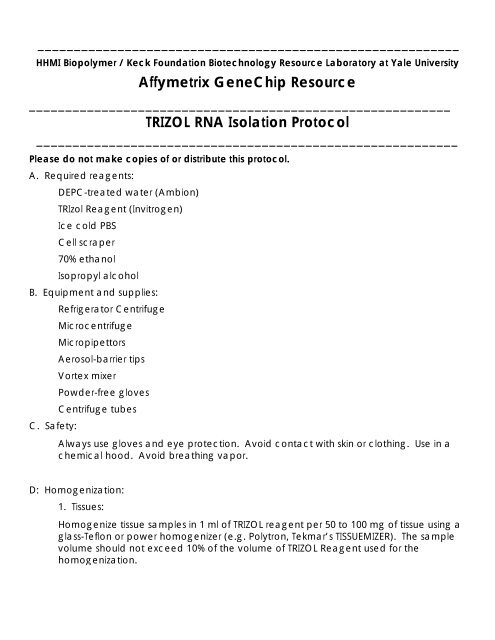TRIZOL RNA Isolation Protocol
TRIZOL RNA Isolation Protocol
TRIZOL RNA Isolation Protocol
You also want an ePaper? Increase the reach of your titles
YUMPU automatically turns print PDFs into web optimized ePapers that Google loves.
__________________________________________________________<br />
HHMI Biopolymer / Keck Foundation Biotechnology Resource Laboratory at Yale University<br />
Affymetrix GeneChip Resource<br />
__________________________________________________________<br />
<strong>TRIZOL</strong> <strong>RNA</strong> <strong>Isolation</strong> <strong>Protocol</strong><br />
__________________________________________________________<br />
Please do not make copies of or distribute this protocol.<br />
A. Required reagents:<br />
DEPC-treated water (Ambion)<br />
TRIzol Reagent (Invitrogen)<br />
Ice cold PBS<br />
Cell scraper<br />
70% ethanol<br />
Isopropyl alcohol<br />
B. Equipment and supplies:<br />
C. Safety:<br />
Refrigerator Centrifuge<br />
Microcentrifuge<br />
Micropipettors<br />
Aerosol-barrier tips<br />
Vortex mixer<br />
Powder-free gloves<br />
Centrifuge tubes<br />
Always use gloves and eye protection. Avoid contact with skin or clothing. Use in a<br />
chemical hood. Avoid breathing vapor.<br />
D: Homogenization:<br />
1. Tissues:<br />
Homogenize tissue samples in 1 ml of <strong>TRIZOL</strong> reagent per 50 to 100 mg of tissue using a<br />
glass-Teflon or power homogenizer (e.g. Polytron, Tekmar’s TISSUEMIZER). The sample<br />
volume should not exceed 10% of the volume of <strong>TRIZOL</strong> Reagent used for the<br />
homogenization.
2. Cells grown in Monolayer:<br />
Rinse cell monolayer with ice cold PBS once. Lyse cells directly in a culture dish by<br />
adding 1 ml of <strong>TRIZOL</strong> Reagent per 3.5 cm diameter dish and scraping with cell<br />
scraper. Pass the cell lysate several times through a pipette. Vortex thoroughly. The<br />
amount of <strong>TRIZOL</strong> reagent added is based on the area of the culture dish (1 ml per 10<br />
cm 2 ) and not on the number of cells present. An insufficient amount of <strong>TRIZOL</strong><br />
Reagent may result in DNA contamination of the isolated <strong>RNA</strong>.<br />
3. Cells Grown in suspension:<br />
Spin cells for 5 min at 300 X g. Remove media and resuspend cells in ice cold PBS.<br />
Pellet cells by spinning at 300 X g for 5 min. Lyse cells with <strong>TRIZOL</strong> Reagent by repetitive<br />
pipetting or by passing through syringe and needle. Use 1 ml of the reagent per 5-10 X<br />
10 6 of animal cells.<br />
4. Incubate the homogenized sample for 5 minutes at room temperature to permit the<br />
complete dissociation of nucleoprotein complexes. Centrifuge to remove cell debris.<br />
Transfer the supernatant to new tube.<br />
E. PHASE SEPERATION:<br />
Add 0.2 ml of chloroform per 1 ml of <strong>TRIZOL</strong> Reagent. Cap sample tubes securely.<br />
Vortex samples vigorously for 15 seconds and incubate them at room temperature for<br />
2 to 3 minutes. Centrifuge the samples at no more than 12,000 x g for 15 minutes at 2<br />
to 8 0 C. Following centrifugation, the mixture separates into lower red, phenolchloroform<br />
phase, an interphase, and a colorless upper aqueous phase. <strong>RNA</strong> remains<br />
exclusively in the aqueous phase. Transfer upper aqueous phase carefully without<br />
disturbing the interphase into fresh tube. Measure the volume of the aqueous phase<br />
(The volume of the aqueous phase is about 60% of the volume of <strong>TRIZOL</strong> Reagent used<br />
for homogenization).<br />
F. <strong>RNA</strong> PRECIPITATION:<br />
Precipitate the <strong>RNA</strong> from the aqueous phase by mixing with isopropyl alcohol. Use 0.5<br />
ml of isopropyl alcohol per 1 ml of <strong>TRIZOL</strong> Reagent used for the initial homogenization.<br />
Incubate samples at 15 to 30 o C for 10 minutes and centrifuge at not more than 12,000<br />
x g for 10 minutes at 2 to 4 o C. The <strong>RNA</strong> precipitate, often invisible before<br />
centrifugation, forms a gel-like pellet on the side and bottom of the tube.<br />
G: <strong>RNA</strong> WASH:<br />
Remove the supernatant completely. Wash the <strong>RNA</strong> pellet once with 75% ethanol,<br />
adding at least 1 ml of 75% ethanol per 1 ml of <strong>TRIZOL</strong> Reagent used for the initial<br />
homogenization. Mix the samples by vortexing and centrifuge at no more than 7,500 x<br />
g for 5 minutes at 2 to 8 o C. Repeat above washing procedure once. Remove all<br />
leftover ethanol.<br />
H. REDISSOLVING <strong>RNA</strong>:<br />
Air-dry or vacuum dry <strong>RNA</strong> pellet for 5-10 minutes. Do not dry the <strong>RNA</strong> pellet by
centrifuge under vacuum. It is important not to let the <strong>RNA</strong> pellet dry completely as<br />
this will greatly decrease its solubility. Partially dissolved <strong>RNA</strong> samples have an<br />
A260/A280 ratio < 1.6. Dissolve <strong>RNA</strong> in DEPC-treated water by passing solution a few<br />
times through a pipette tip.<br />
I. SPECTROPHOTOMETRIC ANALYSIS:<br />
Dilute 1 µl of <strong>RNA</strong> with 39 µl of DEPC-treated water (1:40 dilution). Using 10 µl<br />
microcuvette take OD at 260 nm and 280 nm to determine sample concentration and<br />
purity. The A260/A280 ratio should be above 1.6. Apply the convention that 1 OD at 260<br />
equals 40 µg /ml <strong>RNA</strong>.<br />
Important: For Microarray Experiments <strong>RNA</strong> isolated by TIRZOL reagents needs to be<br />
further cleaned using RNeasy cleanup protocol.<br />
Run gel after RNeasy cleanup protocol to conform integrity of the total <strong>RNA</strong> before<br />
proceeding with cDNA reaction.<br />
REFERENCES:<br />
Chomczynski P, Mackey K. (1995) Short technical report. Modification of the <strong>TRIZOL</strong> reagent<br />
procedure for isolation of <strong>RNA</strong> from Polysaccharide-and proteoglycan-rich sources.<br />
Biotechniques 19(6): 942-5.<br />
<strong>TRIZOL</strong> Reagent technical insert (Invitrogen).
















